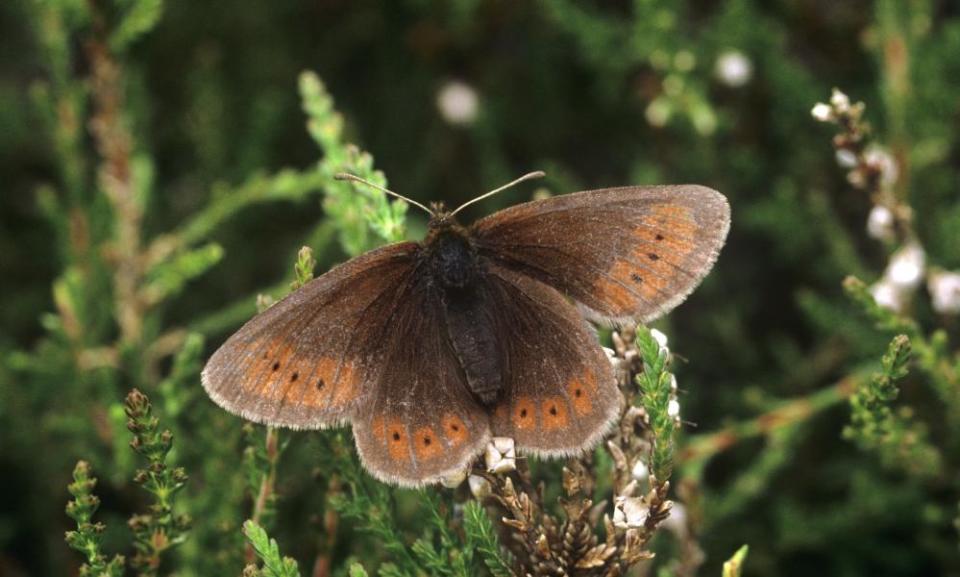How climate crisis made my British butterfly hunt a race against time

It was a long walk up the steep, rocky path, on an unexpectedly warm day – but well worth the effort. Along the banks of a stream, on the slopes of Ben Lawers in the Scottish Highlands, I finally came across my quarry.
A small, unassuming, chocolate-brown butterfly, with a row of black spots edged with orange on its wings: the mountain ringlet. For me, this marked a natural history milestone: the last of Britain’s 61 regularly occurring butterflies which I had yet to see.
As its name suggests, the mountain ringlet is our only truly alpine butterfly, found above heights of 350 metres – about 1,150 feet – in the Lake District as well as the Highlands. Here, it waits patiently in its hideaway in the tussocky grass, sometimes for days on end, until the sun comes out. Only then does it emerge, fluttering fast and low over the ground, occasionally pausing to sunbathe.
When Guardian writer Patrick Barkham took on his quest to see every British species, documented in his delightful book The Butterfly Isles, he managed to complete the task in less than a year. It has taken me almost six decades, if I include the common butterflies I remember seeing as a child; or 20 years, starting from when I first became serious about completing the set.
But Patrick was only aiming to see 59 different butterflies, whereas I have two more on my list: the large tortoiseshell and the long-tailed blue. Both have gained a toehold in the UK in the dozen years since Patrick’s “butterfly quest” of 2009. This pair are recent immigrants from continental Europe, brought across the Channel by warm, southerly winds – having first expanded their ranges northwards as a result of global heating.
Seeing both – the large tortoiseshell on Dorset’s Portland Bill, and the long-tailed blue near Brighton – gave me quite a thrill. But I also felt a sense of foreboding, as I also do when I come across flocks of cattle egrets, now a regular sight near my Somerset home. That’s because while these continental creatures colonise Britain from the south, northern species such as the mountain ringlet may soon be on their way out.
We’ve always known that some species will manage to cope with a rapidly heating climate: those that are already common, widespread and able to adapt to live in a wide range of habitats, and cope with different weather conditions. But we are also becoming increasingly aware that highly specialised species, such as the mountain ringlet, are likely to become victims of their own narrow niche.
Scientists believe the mountain ringlet was one of the first butterflies to recolonise Britain, about 12,000 years ago, following the end of the last Ice Age. To survive the cold, damp and fickle conditions in their upland homes, the caterpillars adapted by slowing down their lifecycle: taking two whole years before they pupate, and later emerge as adults.
But as temperatures rise, and landscapes alter, the mountain ringlet simply has nowhere to go. Those living at the southernmost edge of their UK range, in Cumbria, are already struggling. Populations have moved 150m uphill in the past 50 years; and if we are unable to limit the temperature rises, they are likely to vanish completely within the next half-century. As leading butterfly expert Matthew Oates points out: “Change is now the norm – the real issue is its pace. We can no longer take anything for granted in the natural world, even on something as permanent looking as a mountain.”

The mountain ringlet is not the only high-altitude species facing the threat of extinction in the UK. A specialist suite of fauna and flora can still be found in the Cairngorms, Britain’s only true arctic-alpine biome. These include several iconic Scottish creatures: the mountain hare, snow bunting, and ptarmigan – the only British bird to turn almost completely white in winter.
Just as for the mountain ringlet, rising temperatures are allowing more generalist plants and animals to move higher up the mountain slopes, where they first compete with – and then eventually drive out – the more specialised montane species.
So, what can be done to try to halt – or better still reverse – these declines? One proposal is to translocate mountain ringlets from the Lake District to new homes at higher altitudes in the Highlands; though conservationists are concerned that this might lead to the unwanted mixing of genetically distinct populations. Another, much quicker and simpler solution, is to allow the grass in the butterflies’ habitat to grow longer, mitigating the warming temperatures by creating cooler microclimates, where the butterflies can then find refuge.
But this does feel as if we are tinkering at the edges of the problem. As we know, the real issue is how we limit the overall heating across the globe to 1.5C, and at the same time mitigate any negative effects on wildlife. As recent events here and abroad have demonstrated, the consequences of rapid climate change are already with us. And as this week’s Met Office report warns, the climate crisis will inevitably lead to even more unpredictable and extreme weather here in the UK; which can only be bad news for creatures already living on the edge.
So, although I allowed myself a congratulatory drink to mark seeing all Britain’s species of butterfly, that celebration was tinged with sadness; the fear that, during my own lifetime, the final one on my list might ultimately be doomed.
Stephen Moss is a naturalist and author, and runs the MA Nature and Travel Writing at Bath Spa University. His latest book is Skylarks with Rosie: a Somerset Spring (Saraband)

 Yahoo Movies
Yahoo Movies 